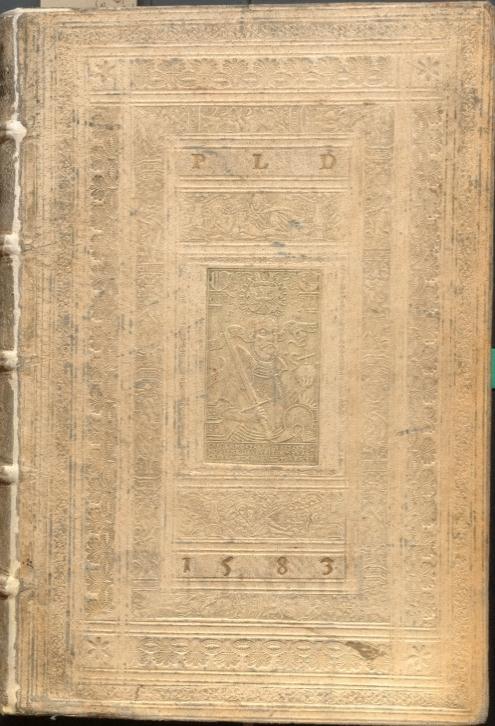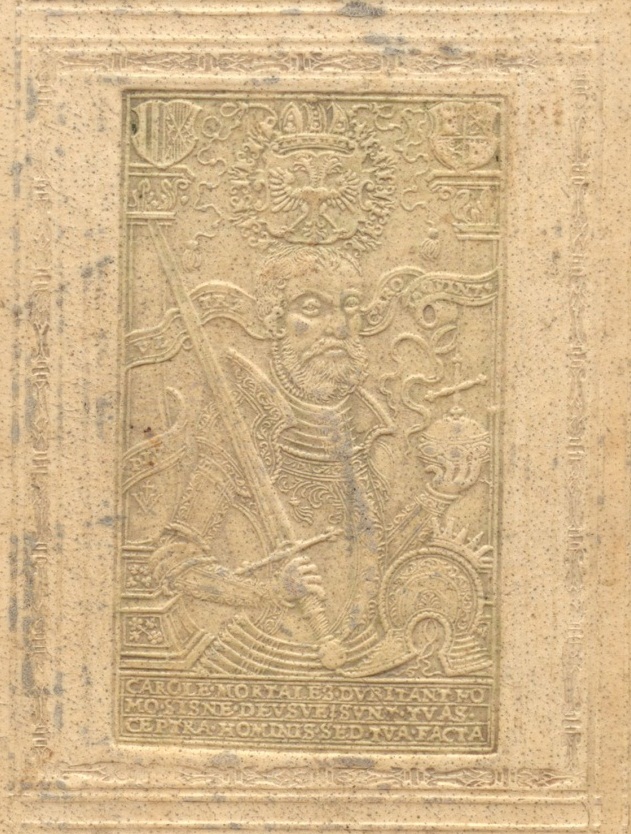Among the different kinds of leathers used to bind books, pigskin can often be recognized by a distinctive creamy colour and a hardness that can look almost like plastic. As one of our in-house experts noted about the sixteenth-century binding shown here, “it just screams ‘pig’!”.
Books from this period were generally acquired unbound, allowing owners to bind volumes according to their tastes and budgets. Sometimes owners bound several books together, and this book is an example. The volume contains two titles: Persicarum rerum historia in xii. libros descripta, a History of Persia by sixteenth-century historian and spy Pietro Bizzarri (dates uncertain); and Rerum Scoticarum historia, a history of Scotland by Erasmian humanist George Buchanan (1506-1582).
This cover decoration is of special note, with its panel stamp of Charles V, Holy Roman Emperor (1500-1558). Panel stamping was popular in sixteenth-century Germany, often with famous historical figures featured in the central panel. Henry Coutts and George Stephen, in their 1911 book, Manual of Library Bookbinding Practical and Historical, comment on this stamp, which was used to decorate several books, as a particularly fine example of the technique. Coutts and Stephen describe the decoration as follows :
The emperor is clad in a rich suit of armour and has an uplifted sword in his right hand, and an orb, surmounted by a cross, in his left. By his side is his helmet surmounted by a radiated crown. Above his head is a shield bearing the arms of Germany, and in the corners are two smaller shields bearing the arms of Aragon, Aragon-Sicily, and Spain. Round the pillars of Hercules at the sides is a ribbon inscribed, PLVS VLTRA, CAROLVS QVINTVS, and below is a tablet with the inscription, CAROLE MORTALES DVBITANT, HOMO SISNE DEVSVE : SVNT TVA SCEPTRA HOMINIS SED TVA FACTA DEI (O Charles, mortals doubt whether thou mayest be man or God: the sceptre of man is thine, but thy deeds are of God). Books adorned with this stamp on one cover usually have on the other an equally beautiful one of John Frederic, Duke of Saxony, with sword and helmet. (p.189)
The McGill front panel is an exact match of that description. The back cover (though less well preserved and more difficult to make out) seems to show the Duke of Saxony mentioned by Coutts and Stephen, which would be fitting given that Bizzarri’s book was dedicated to Augustus I, Duke of Saxony. The Duke’s coat-of-arms faces the dedication page.
The first owner of this volume is not known (though likely had the initials P.L.D., as seen on the cover), but the book is among those previously in the Aylwin Library, part of the heritage of the Morrin Centre and the Literary and Historical Society of Quebec. The signs of provenance include T.C. Aylwin’s signature and the Aylwin Library stamp. (More about this provenance…)
rev. 15/03/2021


